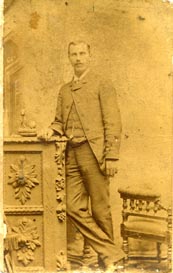Sign up for the Family Tree Newsletter Plus, you’ll receive our 10 Essential Genealogy Research Forms PDF as a special thank you!
Get Your Free Genealogy Forms
"*" indicates required fields

The stories behind this photo attracted me to Beth Maxwell’s email. Is this her great-uncle William Taylor (born in 1861) or her grandmother’s neighbor Jim Hibble (born in 1870)? According to Taylor’s 90-year-old niece, Willie had a water wagon hauling bottles of water from Bloomfield to Jersey City, NJ. Maxwell’s grandmother used to say “Willie spent money like he had it.”
Another suspect is Jim Hibble, who according to Maxwell’s grandmother, wore lots of jewelry in a Virginia country neighborhood where few accessorized themselves similarly. She also noted Hibble’s devil-may-care attitude.
As always, let’s see if the facts add up before we decided who’s who. The absence of a photographer’s imprint means I have no idea where it was taken. A Virginia imprint would’ve indicated Hibble; one from New Jersey would point toward Taylor.
The only details are his clothes. This gent wears the standard outfit of men in the mid-to-late 1880s. Everything about the image fits the decade: He’s wearing a narrow jacket with only the top button fastened, short hair and a mustache. His only jewelry is a watch; not an unusual item for a man to carry regardless of where he lived. The props—decorated pillar and painted backdrop—are also from the period.
A quick comparison of ages provides a tentative ID. In 1885, Taylor was 24, and Hibble, 15. Based on those ages, this probably is Taylor, but to know for sure, Maxwell should try to find another picture of him. She could post this image and the information on a photo-sharing site such as Dead Fred, and invite people to write to her. The more exposure this picture gets, the greater the probability a distant cousin will see it and have additional information and another portrait.
There is one other fact that might help: This man towers over the small chair in the background, suggesting he’s taller than the average 1880s man. I’m basing this impression on the number of photos I’ve seen of people standing next to 19th-century props. Perhaps there’s a family story about his height? (If you’re interested in your ancestors’ stature, read Ohio State University researcher Richard Steckel’s article.)
I love how Maxwell’s family has stories to go with her photos. Pairing up pictures with these colorful tales is a great way for her to scrapbook her family history and entertain relatives. <!–
Watch for props. –><!–
2000–>
ADVERTISEMENT

